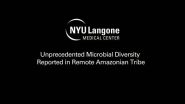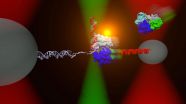(Press-News.org) April 17, 2015 - A multicenter team of U.S. and Venezuelan scientists, led by researchers from NYU Langone Medical Center, have discovered the most diverse collection of bodily bacteria yet in humans among an isolated tribe of Yanomami Indians in the remote Amazonian jungles of southern Venezuela.
By comparison, the microbiome of people living in industrialized countries is about 40 percent less diverse, the scientists estimate. The team reports its findings today in the journal Science Advances.
The results, the researchers say, suggest a link between modern antibiotics and industrialized diets, and greatly reduced diversity of the human microbiome--the trillions of bacteria that live in and on the body and are increasingly seen as vital to our health.
The Yanomami villagers of this study, who have subsisted by hunting and gathering for hundreds of generations, are believed to have lived in total seclusion from the outside world until 2009 when they were first contacted by a medical expedition. Among a rare population of people unexposed to modern antibiotics, the villagers offer a unique window onto the human microbiome.
"We have found unprecedented diversity in fecal, skin, and oral samples collected from the Yanomami villagers," says Maria Dominguez-Bello, PhD, associate professor of medicine at NYU Langone Medical Center and the senior author of the study.
"Our results bolster a growing body of data suggesting a link between, on the one hand, decreased bacterial diversity, industrialized diets, and modern antibiotics, and on the other, immunological and metabolic diseases--such as obesity, asthma, allergies, and diabetes, which have dramatically increased since the 1970s," notes Dr. Dominguez-Bello. "We believe there is something environmental occurring in the past 30 years that is driving these diseases. We think the microbiome could be involved."
In the study, researchers analyzed bacterial samples collected and preserved from 34 of the 54 Yanomami villagers. Among the volunteers, 28 gave skin and oral swab samples, while 11 gave fecal samples. Bacterial DNA from the Yanomami was then compared to samples from populations in the United States, as well as samples from the Amazonian Guahibo Amerindians in Venezuela and residents of rural Malawian communities in southeast Africa. The latter communities represent tribal populations with more exposure to Western culture than the Yanomami.
"There is a gradient of diversity in feces and skin that is inversely proportional to exposure to antibiotics and processed foods," says coauthor Jose Clemente, PhD, assistant professor of genetics and genomics at the Icahn School of Medicine at Mount Sinai. "Even minimal exposure greatly decreases diversity and removes potentially beneficial bacteria from our microbiome."
Among the Yanomami skin samples, the researchers found no single dominant taxonomic group of bacteria, in contrast to the U.S. skin samples, which showed lower diversity and relative high proportions of Staphylococcus, Corynebacterium, Neisseriaceae, and Propionibacterium.
A genetic analysis of gut and oral bacteria also revealed that the Yanomami villagers had bacteria containing genes coding for antibiotic resistance. The bacterial genes conferred resistance not only to natural antibiotics found in the soil but, surprisingly, to synthetic antibiotics as well.
"During the 1940s and 1950s, in the heyday of pharmaceutical antibiotic development, most antibiotics were derived from naturally occurring bacteria in the soil," explains coauthor Gautam Dantas, PhD, associate professor of pathology, immunology, and biomedical engineering at Washington University School of Medicine. "So, we would expect that natural resistance to antibiotics would emerge over millions of years of evolution," he says. "We didn't expect to find resistance to modern synthetic antibiotics."
The resistant genes, however, seem to be silenced because cultured strains of the bacteria were sensitive to antibiotics. "The silenced antibiotic-resistant genes show that you don't need exposure to antibiotics to possess antibiotic-resistant genes," adds Dr. Dominquez Bello.
The presence of resistance genes in microbiota unexposed to antibiotics may help explain the rapid rate at which bacteria develop resistance to new classes of antibiotics, notes Dr Dantas.
The researchers point out that the vast majority of human microbiome studies have focused on Western populations. Investigating microbiomes unexposed to processed diets and antibiotics, they say, can shed light on how the human microbiome may be changing in response to modern culture, and therefore help point to new therapeutics that can rehabilitate disease-causing imbalances in the human microbiome.
INFORMATION:
This work was supported in part by the C&D Fund, the Emch Fund, NIH SCORE-PES RISE, SUCCESS, Helmsley Charitable Trust HSP-007, NIH NIDDK DK062429, NAKFI Synthetic Biology - SB2, NIH Director's New Innovator Award NIDDK DP2-DK098089, NIH NIGMS R01-GM099538, Washington University I-CARES award; UH2AR057506 and the Diane Belfer Program for Human Microbial Ecology, NDSEG graduate fellowship, and HHMI Early Career Scientist.
About NYU Langone Medical Center
NYU Langone Medical Center, a world-class, patient-centered, integrated academic medical center, is one of the nation's premier centers for excellence in clinical care, biomedical research, and medical education. Located in the heart of Manhattan, NYU Langone is composed of four hospitals--Tisch Hospital, its flagship acute care facility; Rusk Rehabilitation; the Hospital for Joint Diseases, the Medical Center's dedicated inpatient orthopaedic hospital; and Hassenfeld Children's Hospital, a comprehensive pediatric hospital supporting a full array of children's health services across the Medical Center--plus the NYU School of Medicine, which since 1841 has trained thousands of physicians and scientists who have helped to shape the course of medical history. The Medical Center's tri-fold mission to serve, teach, and discover is achieved 365 days a year through the seamless integration of a culture devoted to excellence in patient care, education, and research. For more information, go to http://www.NYULANGONE.org, and interact with us on Facebook, Twitter, and YouTube.
Research by scientists at The University of Manchester has revealed that the colour of light has a major impact on how the brain clock measures time of day and on how the animals' physiology and behavior adjust accordingly. The study, for the first time, provides a neuronal mechanism for how our internal clock can measure changes in light colour that accompany dawn and dusk.
In research publishing on April 17th in the Open Access journal PLOS Biology, the researchers looked at the change in light around dawn and dusk to analyze whether colour could be used to determine ...
Scientists from the Icahn School of Medicine, collaborating with a multicenter team of U.S. and Venezuelan researchers, have discovered the most diverse collection of bacteria yet in humans among an isolated tribe of Yanomami Amerindians in the remote Amazonian jungles of Venezuela. Bacterial diversity in the Yanomami, previously unexposed to antibiotics or industrialized diets, was found to be nearly double that of people living in industrialized countries, and was also significantly higher than in other remote populations moderately exposed to modern practices. The team ...
An annual report from Tel Aviv University researchers reveals that anti-Semitic incidents rose dramatically worldwide in 2014, with violent attacks on Jews ranging from armed assaults to vandalism against synagogues, schools, and cemeteries.
The report, released on April 15 by TAU's Kantor Center for the Study of Contemporary European Jewry, recorded 766 incidents, mostly in Western Europe, compared to 554 in 2013 -- a surge of nearly 40 percent. The report called 2014 the worst year for anti-Semitic attacks since 2009. The authors of the report characterized such attacks ...
Researchers at the University of California, San Diego School of Medicine have created an in vitro, live-cell artificial vessel that can be used to study both the application and effects of devices used to extract life-threatening blood clots in the brain. The artificial vessel could have significant implications for future development of endovascular technologies, including reducing the need for animal models to test new devices or approaches.
The findings are published in the current online issue of the journal Stroke.
Cerebrovascular disease covers a group of dysfunctions ...
Early indicators of the malaria parasite in Africa developing resistance to the most effective drug available have been confirmed, according to new research published in Antimicrobial Agents and Chemotherapy.
Researchers at the London School of Hygiene & Tropical Medicine found Plasmodium falciparum malaria parasites with a mutation to the gene Ap2mu were less sensitive to the antimalarial drug artemisinin.
A study in 2013, also led by the School, suggested an initial link between a mutation in the ap2mu gene and low levels of malaria parasites remaining in the blood ...
COLUMBUS, Ohio - Previous research published by researchers at The Ohio State University Wexner Medical Center and three other institutions showed that when children with attention-deficit/hyperactivity disorder (ADHD) and serious physical aggression were prescribed both a stimulant and an antipsychotic drug, along with teaching parents behavior management techniques, they had a reduction of aggressive and serious disruptive behavior.
Now, L. Eugene Arnold and Michael Aman, professors emeritus at the Nisonger Center at Ohio State's Wexner Medical Center, and their colleagues ...
RICHMOND, Va. (April 17, 2015) -- In a recent study, Virginia Commonwealth University School of Medicine researchers predicted which cirrhosis patients would suffer inflammations and require hospitalization by analyzing their saliva, revealing a new target for research into a disease that accounts for more than 30,000 deaths in the United States each year.
The findings could trigger a change in the way researchers study chronic liver disease and associated microbiota, the network of tiny organisms in the human body such as bacteria and fungi that can either bolster an ...
This news release is available in German.
Bonn, April 16 /Tokyo, April 17, 2015 - An international team of researchers at German Center for Neurodegenerative Diseases (DZNE) and Tokyo Institute of Technology (Tokyo Tech) have revealed in a collaborative study - published today in NEURON, that neurons in the eye change on the molecular level when they are exposed to prolonged light. The researchers could identify that a feedback signalling mechanism is responsible for these changes. The innate neuronal property might be utilized to protect neurons from degeneration ...
By combining two highly innovative experimental techniques, scientists at the University of Illinois at Urbana-Champaign have for the first time simultaneously observed the structure and the correlated function of specific proteins critical in the repair of DNA, providing definitive answers to some highly debated questions, and opening up new avenues of inquiry and exciting new possibilities for biological engineering.
Scientists who study biological systems at the molecular level have over the years looked to the structure of protein molecules--how the atoms are organized--to ...
In anticipation of the forthcoming 2015 White House Conference on Aging (WHCoA), The Gerontological Society of America (GSA) has produced a special issue of The Gerontologist that outlines a vision for older adults' economic and retirement security, health, caregiving, and social well-being for the next decade and beyond. And because this year also marks the 50th anniversary of Medicare, Medicaid, and the Older Americans Act, as well as the 80th anniversary of Social Security, articles within the issue also explore ways to safeguard the continuing success of these programs.
The ...



